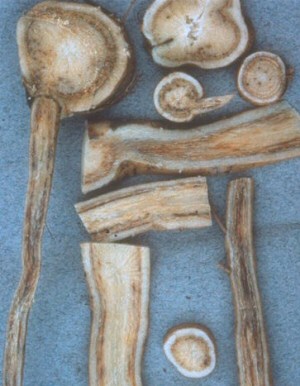Verticillium Wilt
 Causal Agent
Causal Agent
The fungus Verticillium dahliae
Hosts
Many crop plants including cotton, peanuts, etc.
Symptoms
Wilt symptoms generally do not appear before flowering and most often develop during pod set, although plants are probably infected earlier. The upper leaves of infected plants turn pale green, curl, and then die from the leaf margins inward. Infected branches or whole plants become stunted, turn yellow, and may wilt and die. A tan to brown colored discoloration of the vascular system is apparent when affected leaf petioles, stems, or tap root are cut and examined. Well-watered plants may survive for a long period, but the disease itself accelerates maturity.
Control
There is no effective control for Verticillium wilt. Therefore, contamination of clean fields with soil or crop debris from infested fields should be avoided. Once a field is contaminated, the disease can only be partially controlled using cultural practices to minimize yield losses. Adequate irrigation should be applied to prevent moisture stress and to delay the progression of symptoms. Pod loss at harvest can be reduced if the plants are kept alive. Early harvest may be required for fields where a large number of plants are infected early in the season. Crop rotations with susceptible crops such as cotton and potato should be avoided. Long rotations with non-hosts such as corn, grain sorghum, and sudan grass may be beneficial. Although no peanut varieties are resistant to Verticillium wilt, spanish and valencia types are most susceptible. Please contact your local county extension office for current information.

